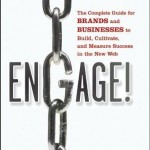Here is a list that will help businesses embrace the methods now available for their marketing efforts through social media platforms, especially via Twitter and Facebook. [This was originally posted on my blog How To Do Social Media by the book.] Continue reading 21 Tips for using Facebook and Twitter for Business via Brian Solis
Tag Archives: Brian Solis
Beginner Blogger’s Workshop: What do I blog about?
Q: Why do you want to blog?
A: Because it’s new and I want to do it.
Q: What do you want to blog about?
A: I don’t know. You tell me.
Blogging is a power strategy for Content Marketing, i.e., communicating about yourself and/or your company to win friends, followers, clients, and customers.
Six Q’s and A’s for Beginning Bloggers
1. What is blogging all about & why are so many people doing it?
Blogging is all about putting your unique voice, opinions, insights, and understandings “out there” to (a) build an online presence, (b) establish yourself as a Thought Leader, and (c) begin conversations and relationships.
Lots of people are blogging — maybe over 200 million worldwide — for a host of different reasons. Most are undoubtedly personal bloggers writing diaries for the world to see. More and more, however, companies, institutions, and nonprofit organizations are understanding that there is a Communication Revolution going on and that the way day-to-day business IS and WILL BE conducted is turning to more authentic, transparent, supportive 2-way conversations, rather than the traditional blasting out of messages.
FURTHER READING:
Answer these nine questions before you decide to become a blogger
2. What do I blog about?
Like most marketing campaigns — as well as personal planning — you should decide on an objective:
What you will blog about has everything to do with why you want to start, build and maintain your online diary/report/journal/lecture.
If you are starting a blog for commercial reasons, then you naturally want to focus your communication towards a “target” audience. Noted social media authority David Meerman Scott suggests that all message-makers should have a clear idea of their consumer profile, i.e., specific data about your prospective readers.
Once you know whom you are writing for and why, you want to make certain that you offer content that is as relevant, informative, creative, and interesting as you can make it.
What’s the very best way to write the best blog articles? Write what you are passionate about.
The best way to improve your blog is to listen to your readers and think about them before — and as — you write.
FURTHER READING:
My story of Peter and “what to blog”
Any and all of Problogger – the hands-down online authority on How To Blog
3. How much effort will it take?
This answer, again, begins with your objective, but I suspect the real question might be: “Do I have to be writing every day to have a successful blog?”
If that is the case, then a simple answer is that Writing Consistently is more important/effective than Writing Daily.
Also, you are the one who decides whether you want short pithy blog posts like Seth Godin and Zahid Lilani or more detailed research reports like Brian Solis or something in between like Adam Singer or Suzanne Vara.
One key is to enjoy what you are doing – or it will show. Start slowly, maybe set a goal of one article a week. When you find that you want to publish more often, then find time to write twice a week . . . and so on. If you are particularly inspired on any day, then try to write an extra post or two that you can publish on a day when you have other commitments.
Another key is to realize that every time you publish new content, you are adding to your site and giving readers [some new] more and more of you. With that in mind, you want to make certain that Everything you publish is something you are proud of.
FURTHER READING:
Spend some time with the bloggers suggested above. Zahid just wrote an article on whether or not Bloggers were Writers
4. If I am not a great writer, how do I get over the fear of writing?
A Great Question! especially if you were never an English major [and what percentage of the world was?].
Here are three things to think about:
- Writing is compulsory thought. When you put fingers on the keyboard and start typing, you “force” yourself to think.
- To over come “writer’s block,” I tell my English composition students to have a reader in mind, e.g. your mother, your best friend, your least favorite uncle, etc. You may see how much easier it is to “talk” when you can envision who is listening.
- Like with any skill, “practice makes perfect” — or at least better.
FURTHER READING:
5. How do you get to blogs? How will people get to my blog?
Two questions here: the first is easy; the second is not so.
Finding blogs to read is as easy as going to Google or some other search engine and putting in some key words. I, personally, have not yet written about the “Fear of Writing” so I simply Googled it and came up with the link listed above.
A better way to find blogs, though, is to follow someone’s recommendation. I gave you five suggestions above, BUT all of those marvelous people write about subjects of interest to me, i.e., social media marketing.
If you want to read and or write about dogs, jewelry, moms, or fashion, you will need to find experts in those fields and (a) see if they have blogs or (b) email them and ask for blog suggestions.
SECOND PART OF THE QUESTION: How will people get to your blog, i.e., how will you get readers?
The basic reason why this is not so easy to answer is because it is not easy to get readers, but here are a few “streamlined” suggestions:
- Write a lot. The more you write, the more Google has to index.
- Comment on other peoples’ blogs enough and they may come to read yours.
- Publicize your blog content on Twitter, Linkedin, Facebook, etc.
- Invite people to Guest Post on your blog.
- Starting out, though, I’d suggest emailing all your friends and letting them know what you are up to.
FURTHER READING:
Go online and search for articles “How to Get Readers”: you’ll find countless titles, but Problogger is best.
6. What are the biggest blogging mistakes?
This is really easy. Check the Guest Post by Suzanne Vara: Avoid These 9 Blogging Blunders
And you might want to check out my own 10 Biggest Mistakes Made by Social Media Newbies
MORE QUESTIONS?
Great! Ask away in the comment section OR, better yet, add your own answers.
Let’s get the blogging story “straight” — a glimpse of the Technorati report
 Just over six months ago [in April 2009], I wrote my first blog post with the announced intention to aim for “A-List status.”
Just over six months ago [in April 2009], I wrote my first blog post with the announced intention to aim for “A-List status.”
Four months later I wrote an article about the “day I thought I’d died and gone to Heaven” — it was actually a report of a panel discussion headlining Steve Rubel among other social media thought leaders discussing a Roadmap for the future.
How very exciting it had been to introduce myself to Steve, who’s been a role model.
I told Steve of the lofty goal I was working towards, and he said,
“You might want to reconsider, Shari. Blogs are losing their status, and you might aim, instead, to be an A-List Thought Leader,” he advised me.
During the panel discussion Steve elaborated on this view:
I do subscribe to Steve’s Posterous stream, but that’s in addition to more than a dozen other blogs I keep up with pretty regularly. [Check my blogroll on the right hand sidebar.]
So . . . every time I read a headline like Brian Solis’ “Rumors of the Death of the Blog are Greatly Exaggerated,” I am encouraged to keep on “keepin’ on,” i.e., BLOGGING towards the A List.
Commentary on the PR 2.0 summary of Technorati’s State of the Blogosphere report
Technorati is a search engine for blogs, and it catalogs more than 112 million blogs. Every year the site comes out with a State of the Blogosphere Report and this year’s findings include information about these topics: professional blogging activities, brands in the blogosphere, monetization, twitter & micro-blogging and bloggers’ impact on US and World events.
The report also includes interviews with more than a dozen well-known, well-respected, and well-read bloggers including Steve Rubel.
Brian Solis’ blog PR 2.0 featured an indepth view of the report
This article will pick out and share pieces of the report that I found interesting and helpful to me as a fairly new blogger.
Brian’s post included color-coded charts recording responses from four categories of bloggers: (a) hobbiests; (b) part-timers; (c) corporate; and (d) self-employed.
1) About 70% of all bloggers felt that “Blogs are getting taken more seriously as sources of information” while 60% agreed that “More people will be getting their news and entertainment from blogs than from traditional media in the next three years.”
HOWEVER
2) Fewer than 40% agreed with the following two statements:
a) “Newspapers will not be able to survive in the next ten years.”
b) “Blogs are often better written than traditional media.”
Re: “Prolificness”
Brian wrote that “those bloggers who rank among the highest according to Technorati Authority post nearly 300 times more than the lower ranked bloggers.”
One Technorati survey question asked “How frequently do you update your blog?
- 20% post once or twice a day
- 27% post 2-3 times per week
- 33% post at least once a week
- Interestingly, 3% of self-employed bloggers post 10 times a day or more! AND 7% post 5-9 times a day.
Why do bloggers blog?
“Self expression and sharing expertise are among the primary motivations for bloggers,” Brian wrote.
To measure the “success” of their blogs, survey respondents chose from the following ten factors, ranked from the most popularly selected to the least:
1) Personal satisfaction
2) Number of unique visitors
3) Number of posts or comments on the blog
4) Number of links to my blog from other blogs
5) Number of RSS subscribers
6) Accolades from other media
7) Number of people favoriting you
8) Blogger’s Technorati authority number
9) Number and quality of new business leads
10) and, finally, in last place for hobbiests/corporate bloggers was revenue; HOWEVER, 39% of part-timers admitted that revenue was an important measure of their success.
What activities do bloggers participate in to attract visitors?
The four most popular activities included (a) Listing the blog on Technorati; (b) Tagging blog posts; (c) Commenting on other blogs; (d) Listing the blog on Google.
Other activities were the following [from more popular to least popular]: (e) Getting listed on a blog directory; (f) Produce content for other blogs or websites; (g) Create a blog on a broader blog network; (h) Attend conferences for bloggers; (i) Pay for online advertising.
The future of Blogging
Here are the eleven blog ideas and tactics proposed for the coming year [from most popular to least]:
1) Blog more frequently
2) Expand some of the topics already blogged about
3) Publish a book
4) Begin using the blog to get speaking engagements
5) Add advertising
6) Begin guest blogging
7) Add video
8) Blog through mobile device
9) Start a new, independent blog
10) Start a new blog on a blog network
11) Blog less frequently.
According to Brian:
“Technorati believes that the next generation of blogs will be more action oriented, not just documenting real time happenings, but driving actual events.”
If you’re a blogger, how would you have answered any of the Technorati questions?
If you don’t blog yet, has any of this information convinced you to “dive in” and start expressing yourself?
FURTHER READING:
Change is never, never easy: The Old PR Pitch must evolve to PR 2.0 Dialogue
“PR 2.0: A Promising Future” — Part 4 of Putting the Public BACK in PR is quite an ambitious undertaking
I covered the first section, ch. 15 on Community Managers in an earlier post. And today’s article only begins to summarize some of the key points in the three very diverse chapters remaining in Part 4.
You’ll find many resources referred to but much deeper explanations are offered in links below, and, of course, the book itself.
Notes from Ch. 16: Socialization of Communication and Service
 One of the true values of our technological capabilities is an opportunity — and a responsibility — to “become experts in the markets, products, and services we represent.”
One of the true values of our technological capabilities is an opportunity — and a responsibility — to “become experts in the markets, products, and services we represent.”
Do not fear negative comments as they can help organizations improve their processes and offerings.
One goal: pull your company into online conversations to help influencers, customers, and prospects gather the information they need. Also empower people to help one another.
MONITORING TIP — Use Google Alerts and “search.twitter.com” –You receive email notifications through Google Alerts for key words that you sign up for. If you use a desktop application like Tweetdeck, then you can set up columns to regularly stream mentions of your keyword from search.twitter.com. You could be receiving regular updates about your company, your products, and your competitors.
NING.COM: A new one for me, but I tried it and like it. Here you can set up YOUR OWN social network. For example, in my fledgling social media consulting business, I can offer SM Newbies a “comfortable” place to gather online and ask me and my interns questions about social media in a Newbie forum.
Finding WHICH communities your customers participate in is critical if you want to engage them where they are.
“Feel the pain and deliver the painkiller.”
If you are listening to problems, you can address them before your customers go elsewhere for solutions.
REVERSE ENGINEERING [one of my favorite concepts to (a) deliberate over and (b) put to USE
Here is the PPBPR 3-step reverse-engineering model:
- Determine Who, Where, How — prospects are communicating.
- Listen.
- Adapt to their needs.
Notes from Ch 17 – The Rules for Breaking News
Concept of embargo: When PR people distribute news to those who will write about it [e.g., reporters, bloggers], the “embargo” sets a time WHEN the news may be broadcast.
Some bloggers are now saying that . . .
“PR agencies are no longer necessary”
Do you agree? Who does — and why? Who doesn’t — and why?
Here’s an opinion on the topic from Steve Rubel – thought leader, lifestreamer, and top PR guy for top international PR firm:
“Does the thrill of the chase make PR obsolete? It’s our view that increasingly, bloggers (and maybe journalists too) simply don’t want our help. Many bloggers — particularly those who cover tech — love to discover new things and experience them on their own.”
Key difference between bloggers and journalists: many bloggers want the news way before the story — because, in many cases, They are the Innovators and Early Adopters.
One key similarity: RELATIONSHIPS are All Important, no matter the medium or the writer/broadcaster.
Ch 18 – A New guide to metrics
The whole idea behind PR 2.0 is that the Old Ways of PR no longer work with today’s audiences OR the people who influence them. Same goes for Old Measurements: Organizations should NOT determine the ROI of their PR campaigns by the number of stories written in newspapers or broadcast on TV.
“PR 2.0 favors engagement more than hits, referrals more than eyeballs, activity more than ad value, sales more than mentions, and market and behavioral influences more than the weight and girth of clip books.”
People = Power
Perception = sum of all the conversations on the Social Web
Measuring the frequency and tone of conversations is the new measure of effectiveness, and here are some tracking tools to check out:
- Google Alerts [mentioned above]
- Radian6
- BuzzLogic
- Neilsen BuzzMetrics
- Blogpulse Conversation
- and a host of social networks from Facebook to YouTube.
Tracking conversations finds you WHAT?
When you listen, you will likely hear seven different types of comments:
- Asking for info or help
- Answering questions related to your brand
- Sharing opinions/observations
- Offering suggestions
- Expressing dissatisfaction
- Promoting competition
- Reposting relevant content and market data
“Through proactive and consistent listening, measurement, and refinement, PR will not only justify its role in social marketing, but also more effectively enhance relationships, build trust, cultivate communities, and increase sales . . .”
i.e. INCREASE ROI
What’s YOUR TAKE on the new methods and measurements of Public Relations? If you read this post BEFORE Tuesday, Sept 22 at 8pm EDT / 5pm PDT, you can join me and others for the social media book discussion on Tweetchat. Just put in the hashtag #smbookclub and comment OR just observe.
An archive will be available after the discussion, but you can always weigh in with a comment below.
FURTHER READING:
Yes, Shari, Micromedia can support and inspire great conversation

When I first read chapter 13 in Putting the Public Back into PR, I had my doubts as to whether Twitter was really the place for great convo — i.e. conversation.
But two recent experiences convinced me that rapid-fire, off-the-cuff, succinct wordings could in fact power “engaging” and “enlightening” experiences — not to mention the opportunity for community-building.
Last night I moderated the #smbookclub discussion for Part 3 of Brian Solis and Deirdre Breakenridge’s Putting the Public Back in PR. This morning I participated in their discussion at #PRStudChat. Both complete discussions are archived and be followed simply by searching the hastags.
Content/conclusions from the book discussion:
“Relax and let chaos reveal its relevance to you.” Susanna Stinnet
- The conversations [“convos”] are happening. If you are part of them, you can affect change and make a difference.
- Companies that use today’s tools will be ahead of the game, even if those particular tools change or lose their vitality.
- Social media will continue to evolve; it will not go away.
- Social media platforms are great ways to meet people.
- Before engaging anyone, first observe and understand the cultures and behaviors necessary to participate in these communities.
- Marketing jobs have moved from monologues to dialogue.
- Avoid the clutter and build relationships.
- Build meaningful relationships that will contribute to company’s brand equity, resources, and overall bottom line.
“Twitter and Facebook are really good for listening and developing relationships — and then driving to where you can talk in more depth either via email or phone.” Paul Salinger
“Social media is forcing changes that should have happened a long time ago in everything related to business.” Cherisse Rivera
Notes for further “conversation/content”:
1) Check out #PRStudChat for hour dialogue between Brian, Dierdre, PR students and pros.
2) Read my reviews of Putting the Public Back in PR:
- Part 1: True Value of New PR
- Part 2: Facilitating Conversations
- Part 3: Social Media Tools – topic of this week’s social media book discussion
- Part 4, ch. 15: Community Managers – first chapter in section to be discussed next week #smbookclub
3) Join the chat next Tuesday on Tweetchat.com #smbookclub 8 pm EDT/5 pm PDT
For those of you who do check out #PRStudChat OR if you attended, please comment with your favorite quotes from that conversation.
Community Managers: Your organization’s guide along Social Media Revolutionary Road

Hiring or Applying?
You’ll do well to check out chapter 15 in the social media/PR 2.0 book I’ve been reviewing — Putting the PUBLIC Back in Public Relations by Brian Solis and Dierdre Breakenridge.
Who OWNS the responsibility of managing social media conversations for an organization?
Brian and Dierdre conclude that “every facet of a business is responsible for its channel of social monitoring and interaction,” and strategies and tactics for each department can best be directed by a community manager — or one of several other titles:
- Community Advocate
- Brand Ambassador
- Social Media Specialist
- Social Media Evangelist
- VP of Social Media
- Chief Social Officer
- Community Relations Manager
- Community Builder
The socialization of the corporate marketing infrastructure isn’t a matter of IF it should happen, but instead WHEN it will happen.
Marketers in every industry are agreeing with a core social media concept that People Do Business with People, not Entities: “Brands don’t engage with people — people engage with people.”
The dynamic of listening to and engaging in everyday dialogue is often referred to as the conversation.
The conversation is between the the organization representatives and the new influencers which comprise customers, peers, employees, partners, enthusiasts, bloggers, reporters, and analysts.
What is it that you learn by listening?
Whether the online conversations are positive, neutral, or negative, the insight garnered from listening and observing will reveal opportunities not just for engagement, but also for gathering real-world intelligence
— the type of information that is “ear to the street” and that you can feed back into your organization to improve the existing service, product, and management infrastructure.
The authors included a discussion of the Four Tenets of the Community Manager by Forrester social computing analyst Jeremiah Owyang:
- Community Advocate: represents the organization.
- Brand Evangelist: promotes events and products.
- Savvy Communication Skills: shapes editorial and mediates disputes
- Gathers Community Input: gathers and shares comments from marketplace conversation
Here’s a definition of the role of the community manager by a community manager — Connie Bensen:
A community manager is the voice of the company externally and the voice of the customers internally. The value lies in the community manager serving as a hub and having the ability to personally connect with the customers and providing feedback to many departments internally.
Community Managers: Please feel free to add your experiences and tips for organizations looking for individuals to fill this role AND for communications specialists seeking these positions.
Social Media Tools — are just “tools,” not the all-important-strategies
Part 3: Putting the PUBLIC Back in Public Relations

If you think about the title of this post, I hope you’ll get the message that even though it’s the SM platforms, i.e. Twitter, Facebook, Friendfeed, etc. that get the “Buzz,” it’s HOW YOU USE THEM that is their true significance.
Because Brian and Dierdre devote a lot of ink to individual tools in this section of PPBPR, readers should note that some of the content will be outdated by the time they read it — the Web is so dynamic, and the Social Web is even more so.
But that is the Key Point of this section:
“Remember that these are merely tools to communicate with others; they’re not representative of the strategies and methodologies for observing and communicating with people.” — p. 153 PPBPR
Four chapters in Part 3: “Participating in Social Media”
Ch 11 – Technology Does Not Override the Social Sciences
Ch 12 – Social Networks: The Online Hub for Your Brand
Ch 13 – Micromedia
Ch 14 – New “Marketing” Roles
Valuable re-quote from The Cluetrain Manifesto:
These markets are conversations. Their members communicate in language that is natural, open, honest, direct, funny and often shocking.
Whether explaining or complaining, joking or serious, the human voice is unmistakably genuine. It can’t be faked.
Most corporations, on the other hand, only know how to talk in the soothing, humorless monotone of the mission statement, marketing brochure, and your call-is-important-to-us busy signal.
Same old tone. Same old lies.
My take-aways:
- Conversations will go on — with or without you. Watch that the competition doesn’t get there first.
- Negativity in the conversation can present opportunity, e.g., to change a perception.
- Basic PR has not changed: YOU are the communication bridge between your company and the people you want to reach.
- Social media helps uncover relevant online communities: LISTEN, OBSERVE and, then, ENGAGE.
- Reach out to individuals not audiences.
- Everything you do online today, whether it’s personal or on behalf of a company you represent, contributes to public perception and overall brand resonance.
- Social networks are forcing PR practitioners to evolve — to step out from behind a cloak of anonymity.
- “Socialize to Survive” : The days of focusing solely on Web stickiness, eyeballs, and click-throughs is waning. These are the days of immersion, conversation, engagement, relationships, referrals, and action.
NOW FOR SOME QUESTIONS: (especially for those of you who may want to consider discussing this chapter next Tuesday, September 15, at the 8 pm EDT/5 pm PDT meet-up of #smbookclub)
- As a “communication pro,” how do you [or anyone] keep on top of Networks and Apps?
- What platforms and apps have you chosen to use and why?
- What success stories have you had/or heard about that have impacted the way you feel about social media?
- How do you feel about “lifestreams” and/or posting updates on multiple sites simultaneously?
- Can discussions really take part in micromedia?
- Where would you like to see Social Media go from here?
I hope to hear your thoughts in comments below and/or next Tuesday during our book discussion.
Next Post: Description of Community Manager role as organization’s guide along Social Media Revolutionary Road
No apologies from this PR 2.0 evangelist: Putting the PUBLIC Back in Public Relations

Many of us who have taught Shakespeare know that the Great Bard based his renowned plays on history or legend — in other words, his genius was not in the originality of plots, but in the art of his storytelling.
Art, imagination, creation are products of passion. Passion is the way we move forward. Passion is the way I, personally, am moving forward.
Book Review – Part One
This blog is a chronicle of my newly embraced career as a Social Media Evangelist. And one of the people most responsible is Brian Solis, who graciously and enthusiastically accepted an invitation to speak to two Public Relations classes at San Francisco State last spring — despite his hectic schedule advising clients, speaking at conferences, attending mashups, and promoting his most recent book Putting the PUBLIC Back in Public Relations.
To my mind, Brian’s book, co-written with Deirdre Breakenridge, is a conversation about a clash — the confrontation between old thinking and new realities.
Change is hard. People like the comfort of the Way it Was, and the Way They Know: but that is hardly a roadmap for progress.
How Social Media is Reinventing the Aging Business of PR
Below is a listing of passages I particularly liked from Part I: THE TRUE VALUE OF THE NEW PR
- Public Relations has always been about building relationships. It should never have been about spin.
- The first thing a PR practitioner should learn is to uphold integrity and credibility at all times.
- Listeners make the best conversationalists.
- PR 2.0 is creating a new toolkit with which companies can share content with new influencers as well as customers.
- PR has begun to look less like a typical broadcast machine and more like a living, breathing entity capable of also participating in conversations with publics.
- The new goal for PR is to understand the communities of people we want to reach and how to engage them in conversation without marketing to them.
- PR is rooted in democratized content, strengthened by enthusiasm and market intelligence, and powered by conversation.
- We no longer Pitch — we Participate. We no longer Sell stories — we Tell them.
- The New PR is all about 3 T’s: Transparency, Truth, and Trust.
The Social Media Book Club discussed Part I of the book last week, and here is an archive of the remarks. Tonight at 8pm EDT [5pm PDT] you can catch the discussion of part II: Facilitating Conversations: New Tools and Techniques on Twitter #smbookclub. Here is a Book Club calendar. For more info, contact @ready2spark
Listening Redux: First rule to success in business

My SFSU Business Communication students learn three rules to Business Success in their first class session:
(1) Listen Carefully
(2) Read Carefully
(3) Follow ALL Directions
The suggestion to students — and everyone — that active listening is a skill can be easily disregarded as many people simply hear the tip and move on.
That is, they get ready for the next “rule” without really understanding the implications, and the difficulty, of what it means to really listen.
An earlier post of mine When communication adds up to a big fat zero proposed that all the new technology and accompanying tools and tactics were of little value if strategic planners did not first begin by Listening Carefully to online voices in their community.
This advice reverberates through the web in social media blog posts countless times every day. Today, in fact, a Brian Solis update on my Facebook stream pointed to PR 2.0 guest poster Michael Brito‘s rant against companies that listen but don’t act.
Rule Number One: LISTEN CAREFULLY
Last evening’s rigorous SFSU Business Communication class [we were learning to write business reports] was sweetened with an anecdote from one student who had really learned the power and rewards of LISTENING CAREFULLY at work that very afternoon.
New to his position in a downtown business, my student was invited to a meeting featuring a high level executive from headquarters. He [we’ll call him Adam, not his real name] had heard that this exec was noted for long, sometimes very dry speeches. But Adam was determined to pay close attention and practice all the “active listening” tips we had discussed in class.
“It was hard because lots of my coworkers were chatting and not paying attention, but just the same I wanted to focus on what was being said. I kept thinking about how important that was,” Adam told me.
The speaker did go on and on. And as hard as it was for Adam to keep his focus, he managed to do it . . .
And then the speaker stopped, looked around the room, and asked “Who heard what I just said?”
There was silence.
Adam cautiously raised his hand and repeated the last few facts related by the speaker, who acknowledged the response and asked Adam to stay behind after the meeting.
Adam was terrified, but not for long. After the meeting, the executive shook his hand, asked for his name and position, and said:
Good job, Adam. I’m going to be looking out for you. You are bound to go far in this company.
Adam was overjoyed and naturally was bursting to tell me. I was overjoyed and bursting to tell my audience — both Adam’s classmates and my blog readers.
What would our business and personal lives be like if we ALL made even small efforts to listen carefully when people were talking to us and with us?
Next post: Networking Tips
